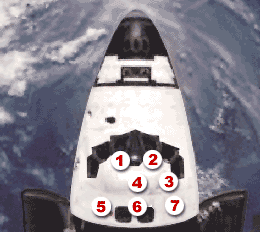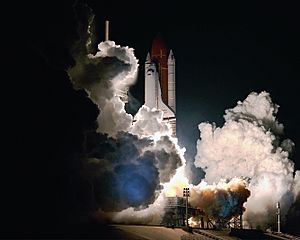STS-33 facts for kids
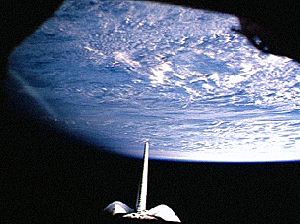
Discovery in orbit; in-flight photography on this Department of Defense (DoD) support mission is limited.
|
|
| Names | Space Transportation System-32 STS-33R |
|---|---|
| Mission type | DoD satellite deployment |
| Operator | NASA |
| Mission duration | 5 days, 0 hours, 6 minutes, 48 seconds (achieved) |
| Distance travelled | 3,400,000 km (2,100,000 mi) |
| Orbits completed | 79 |
| Spacecraft properties | |
| Spacecraft | Space Shuttle Discovery |
| Landing mass | 88,125 kg (194,282 lb) |
| Payload mass | 21,000 kg (46,000 lb) |
| Crew | |
| Crew size | 5 |
| Members | |
| Start of mission | |
| Launch date | 23 November 1989, 00:23:30 UTC |
| Rocket | Space Shuttle Discovery |
| Launch site | Kennedy Space Center, LC-39B |
| Contractor | Rockwell International |
| End of mission | |
| Landing date | 28 November 1989, 00:30:18 UTC |
| Landing site | Edwards Air Force Base, Runway 4 |
| Orbital parameters | |
| Reference system | Geocentric orbit |
| Regime | Low Earth orbit |
| Perigee | 519 km (322 mi) |
| Apogee | 519 km (322 mi) |
| Inclination | 28.45° |
| Period | 88.70 minutes |
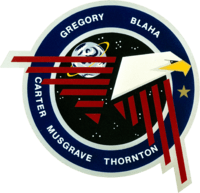 STS-33 mission patch 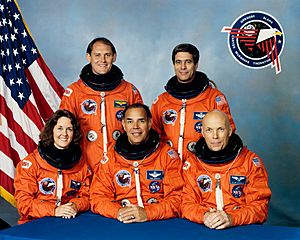 Back row: Manley L. Carter Jr. and John E. Blaha Front row: Kathryn C. Thornton, Frederick D. Gregory, F. Story Musgrave |
|
STS-33 was a NASA Space Shuttle mission. The Space Shuttle Discovery carried out this flight. Its main job was to put a special satellite into space for the United States Department of Defense (DoD). The DoD is a part of the U.S. government that handles military and national security.
This was the 32nd Space Shuttle mission ever. It was also the ninth flight for Discovery. It was the fifth shuttle mission that helped the DoD. STS-33 was the last Space Shuttle launch of the 1980s. Because it was a secret mission for the DoD, many details about it are still classified.
Discovery launched from Launch Complex 39B in Kennedy Space Center (KSC), Florida. The launch happened on November 22, 1989, at 7:23:30 p.m. EST. The shuttle landed at Edwards Air Force Base, California, on November 27, 1989, at 7:30:16 p.m. EST.
The mission was officially called STS-33R. This was because the name STS-33 was first given to the Challenger mission that had a terrible accident. To avoid confusion, future missions from STS-26 to STS-33 added an "R" to their names.
Meet the Crew
| Position | Astronaut | |
|---|---|---|
| Commander | Frederick D. Gregory Second spaceflight |
|
| Pilot | John E. Blaha Second spaceflight |
|
| Mission Specialist 1 | Manley L. Carter Jr. Only spaceflight |
|
| Mission Specialist 2 | F. Story Musgrave Third spaceflight |
|
| Mission Specialist 3 | Kathryn C. Thornton First spaceflight |
|
Where the Crew Sat
The astronauts had specific seats for launch and landing. Seats 1 to 4 were on the Flight Deck, which is like the cockpit. Seats 5 to 7 were on the Middeck, a lower area.
| Seat | Launch | Landing | |
|---|---|---|---|
| S1 | Gregory | Gregory | |
| S2 | Blaha | Blaha | |
| S3 | Carter | Thornton | |
| S4 | Musgrave | Musgrave | |
| S5 | Thornton | Carter |
Mission History
The name STS-33 was first planned for the Challenger mission that ended in disaster. After the Challenger accident, NASA restarted the mission numbering. The first flight after the accident was called STS-26.
An astronaut named S. David Griggs was supposed to be the pilot for this mission. Sadly, he passed away in a plane crash in June 1989. He was training for the mission at the time. A single gold star on the mission patch remembers him. John E. Blaha took his place as pilot. Another astronaut on this flight, Sonny Carter, also passed away later in a plane crash in April 1991.
Mission Details
STS-33 was first set to launch on November 20, 1989. However, it was delayed. There were some issues with the electronics that controlled the shuttle's solid rocket boosters (SRBs). These boosters help the shuttle lift off.
This mission was the third time a Space Shuttle launched at night. It was also the first night launch since shuttle flights began again in 1988. Flights had stopped after the Challenger disaster in 1986.
During the mission, Discovery put one satellite into space. This satellite was called USA-48. Many experts believe it was a secret Magnum satellite. This type of satellite is used for ELINT, which means it collects electronic signals. It was likely sent to a geosynchronous orbit. This orbit allows a satellite to stay over the same spot on Earth.
This mission was thought to be very similar to an earlier secret mission, STS-51-C, from 1985. According to news reports, USA-48 was meant to listen in on military and diplomatic communications. These communications were from countries like the Soviet Union and China. The satellite launched on STS-33 was believed to replace an older one. The older satellite was running out of fuel to stay in its position over the Indian Ocean. However, an astronaut named Gary E. Payton said in 2009 that the STS-51-C satellite was "still up there, and still operating."
Discovery first entered an orbit that was about 204 kilometers (127 miles) by 519 kilometers (322 miles) high. Its path was tilted 28.45 degrees to the equator. The shuttle then used its Orbital Maneuvering System (OMS) engines three times. These engines help change the shuttle's orbit. The first burn made the orbit more circular, at 519 kilometers (322 miles) high.
The USA-48 satellite was released on the seventh orbit. It then fired its Inertial Upper Stage (IUS) booster. This booster successfully pushed the satellite into a geostationary transfer orbit (GTO). This was the eighth IUS launched by the shuttle. It was the seventh one that worked perfectly.
The STS-33 mission had a small problem with a leak in the Waste Collection System inside the cabin.
Scientists also watched STS-33 from the ground. The U.S. Air Force Air Force Maui Optical and Supercomputing observatory (AMOS) used a large telescope in Hawaii. They observed the shuttle five times. They took pictures to study how gases from the shuttle's engines interacted with oxygen and nitrogen in space.
The landing was first planned for November 26, 1989. But it was delayed for a day. This was because of strong winds at the landing site. Discovery landed at Edwards Air Force Base, California. The landing happened on November 27, 1989, at 7:30:16 p.m. EST. The mission lasted for 5 days, 0 hours, 6 minutes, and 46 seconds.


